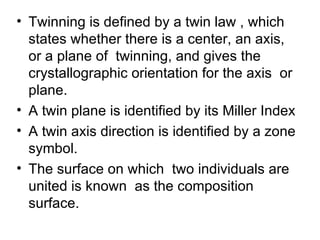- 1. TWINNING
- 2. Inter growth of crystals Parallel growth- Intergrowth patterns of well-formed crystals (as well as anhedral grains ) of same crystalline substance. Epitaxis- The overgrowth of one crystal on another such that the structural orientations of the two minerals are specifically related. The minerals themselves do not have to be closely similar in their structure. Twins or twinned crystals- A type of crystllographically controlled (nonrandom) intergrowth occurs when two crystals of the same substance are related by the symmetry element that is not normally present in either individual crystal.
- 3. TWINNING A twin is a symmetrical intergrowth of two (or more) crystals of the same substance. Crystallographically controlled such intergrowths are called twinned crystals. The study of the types of twin crystals shown by different substances and the formulation of the laws governing their formation is an important part of crystallography
- 4. The operations (twin elements) that may relate a crystal to its twinned counterpart are: Reflection by a mirror plane (twin plane) Rotation about a crystal direction common to both (twin axis) with the angular rotation generally 180 0. Inversion about a point (twin centre).
- 5. Twinning is defined by a twin law , which states whether there is a center, an axis, or a plane of twinning, and gives the crystallographic orientation for the axis or plane. A twin plane is identified by its Miller Index A twin axis direction is identified by a zone symbol. The surface on which two individuals are united is known as the composition surface.
- 6. If this surface is a plane , it is called the composition plane. The composition plane is commonly, but not invariably the twin plane. Twin plane is always parallel to a possible crystal face but never parallel to a plane of symmetry . Twin axis is a zone axis or a direction perpendicular to a rational lattice plane; but it never can be an axis of even rotation (2,4, 6-fold) if the twin rotation involved is 180 0.
- 7. Twinned crystals Contact twins. Have a definite composition surface separating the two individuals and the twin is defined by a twin plane. Penetration twins These are made up of interpenetrating individuals having and irregular composition surface, and the twin law is usually defined by a twin axis direction.
- 8. Repeated or multiple twins are made up of three or more parts twinned according to the same law. If all the successive composition surfaces are parallel the resulting group is a polysynthetic twin. If the individuals of the polysynthetic twin are thin plates , the twinning is called lamellar (eg. Plagioclase)
- 9. If the individuals of the multiple twin are related by twin planes that are different planes of the same crystal form, a cyclic twin results. (rutile, chrysoberyl) Multiple penetration twins may also result if two equivalent lattice rows act as twin axes simultaneously, these twins are also cyclic in form, as found in aragonite. (aragonite)
- 10. Twin laws The description of twin law consists of stating the crystallographic orientation of the twin element, axis, or plane. Triclinic system. Albite law of twinning with the (010) the twin plane. Another important type of twinning in triclinic feldspar is according to the pericline law, with (010)as the twin axis.
- 11. When albite and pericline twins are closely interwoven, a typical cross-hatched or ‘tartan’ pattern can be seen under the microscope as in microcline.
- 12. Monoclinic system Twinning on (100) and (001) is most common. Gypsum, pyroxene and hornblende commonly form simple contact twins with (100) the twin plane. Gypsum twin crystals are called swallow-tail twins. In orthoclase : manebach twin with (001) as the twin plane, and a Baveno twin with (021) as the twin plane, and The most common twin in orthoclase Carlsbad twin, an interpenetration twin in which the c axis, (001), is the twin element. In this case the two individuals are united on an irregular surface roughly parallel to (010)
- 13. Orthorhombic system Twin plane most commonly parallel to the a prism face. The contact twin of aragonite and the cyclic twins of aragonite and cerussite are all twinned on (110) Staurolite commonly forms cruciform twin crystals, which are penetration twins with twin plane (031) giving a nearly right-angle cross, or with twin plane (231) giving a sawhorse twin with an angle of about 60.
- 14. Hexagonal system Twinning is very common in calcite, quartz Twin plane in calcite is (0001) (not a symmetry plane in calcite), and is also the composition plane. Contact and polysynthetic twins also seen as a result of pressure, as in marble.
- 15. Twin crystals of quartz may occur as: Brazil twins- brazil law with the twin plane parallel to (11-20). Here right and left hand individuals have formed a penetration twin. Dauphine twin- a penetration twin with c the twin axis. Such twins are composed of two right or two left hand individuals. Japanese law- with the twin plane (11-21). The reentrant angles usually present on twinned crystals do not shot on eithe brazil or dauphine twins. This twin law is named from the prevalance of these twins at a locality in Kai province, japan.














